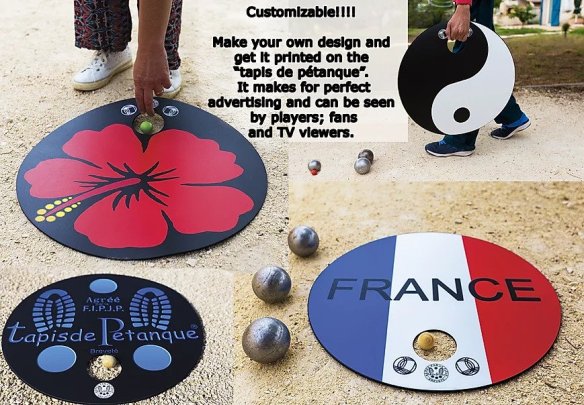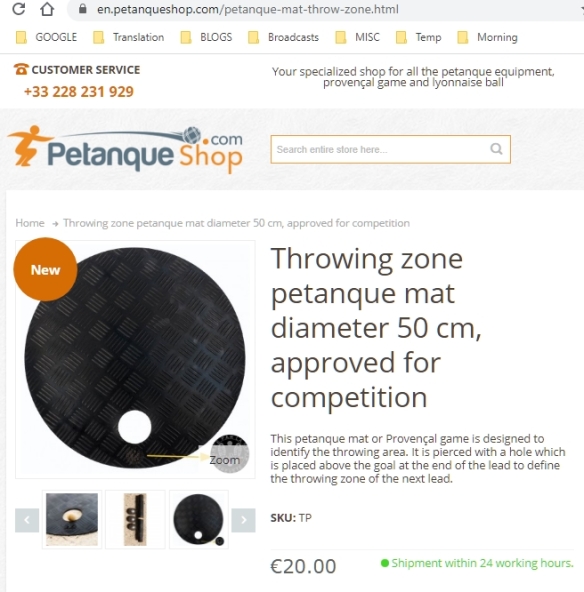There is a new product on the market— the “petanque mat” (tapis de pétanque or tapis de lancement). It is a 50cm circular piece of vinyl polymer (rubber). It is 3mm thick. You place it on the ground like a plastic circle, and when you throw, you stand ON it rather than IN it.
 It is manufactured by a Franch company, Tapis de Pétanque (tapisdepetanque.com/). Their web site says that these petanque mats were approved by the FIPJP in 2019, and they put a stamp on the mats to prove it. (I haven’t found anything on the FIPJP website that documents or announces this approval… but then the FIPJP said nothing a few years ago when it approved OBUT’s paramagnetic “black jack”.)
It is manufactured by a Franch company, Tapis de Pétanque (tapisdepetanque.com/). Their web site says that these petanque mats were approved by the FIPJP in 2019, and they put a stamp on the mats to prove it. (I haven’t found anything on the FIPJP website that documents or announces this approval… but then the FIPJP said nothing a few years ago when it approved OBUT’s paramagnetic “black jack”.)
The mat comes in a plain black “classic” design (above) for about €20 and a slightly thicker (4mm) “luxe” version. The luxe version comes in a variety of preprinted designs for about €70, and you can have one printed with a custom design for around €140.

The touted benefits of the mat are that it can be rolled up, making it more portable than a plastic circle; it is comfortable to stand on; you can’t trip on the edge when stepping off of it; a player standing on it cannot move it; and it causes no disturbance of the ground that needs to be repaired at the end of the mène. I think we have to take those claims with a few grains of salt. It’s still possible, of course, to trip on the edge when stepping ON to the mat. And it is possible to kick and move the mat when you aren’t actually standing on it, so you still must mark it.
I think it is a neat idea, but for manufactures and vendors of petanque equipment, not for players. Basically, it is just another platform for advertising. In the future we may start to see mats with OBUT logos in televised championships, but for everyday grass-roots games nobody is going to spend €140, or €70, or even €20 on a mat when they can get a perfectly serviceable plastic circle from Decathlon for $7.
One consequence of these mats— assuming that the FIPJP now really does recognize/approve the use of mats as well as plastic circles — might be that grassroots players will begin cutting 50cm circles out of pieces of carpet tile, scrap rubber or carpet, to make their own home-made mats. Personally, the idea of lugging around a dirty old piece of carpet doesn’t appeal to me— I’d rather just draw a circle on the ground, in the traditional way. Or I could raid my grand-daughter’s college savings fund and purchase one of these tapis de pétanque— after all, they are washable.


